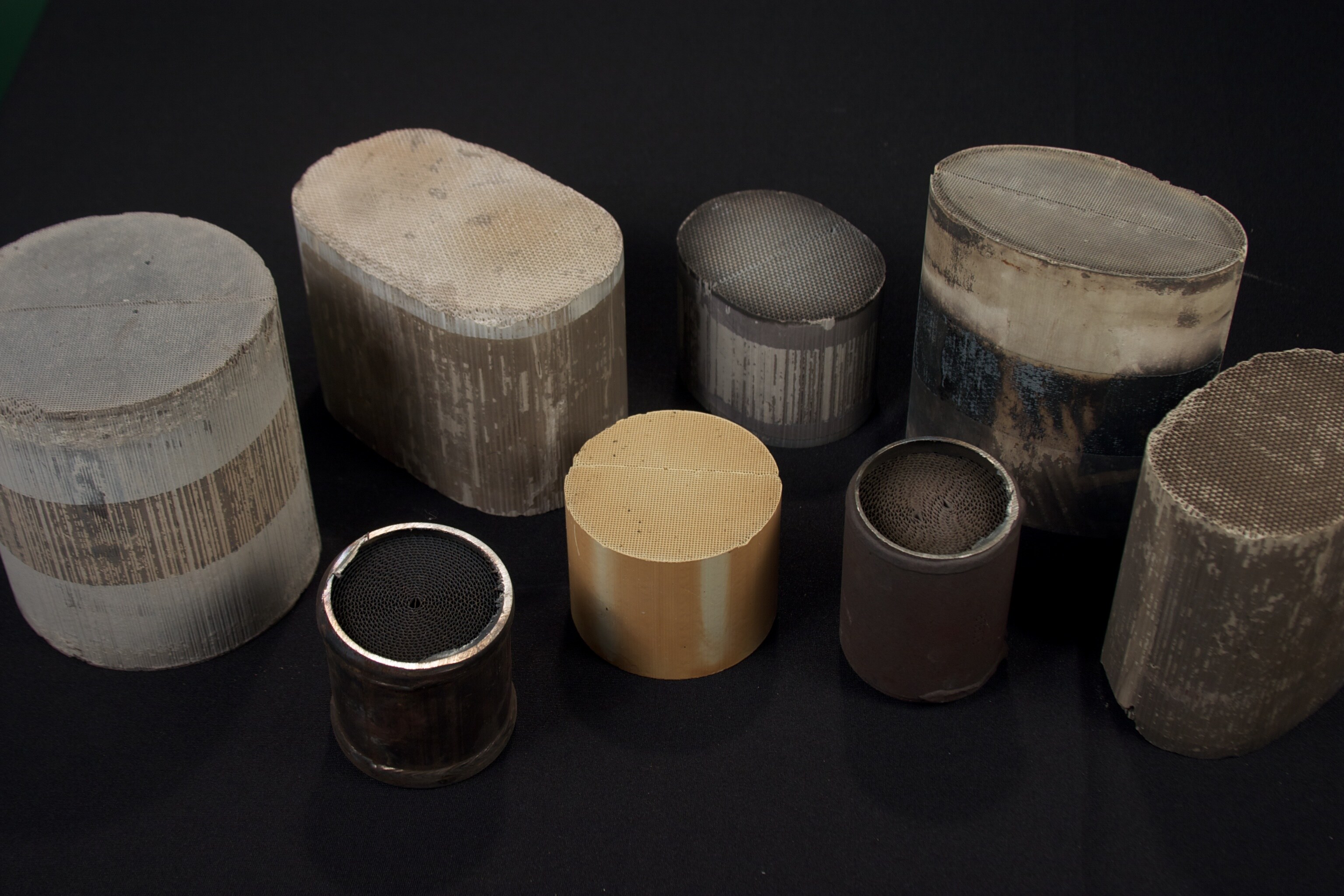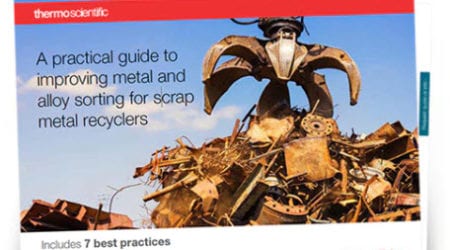 Platinum Group Metal Recovery from Spent Catalytic Converters Using XRF
Platinum Group Metal Recovery from Spent Catalytic Converters Using XRF
A catalytic converter is a device used to convert toxic vehicle emissions to less harmful substances by way of catalyzed, or accelerated, chemical reactions. Most present-day vehicles that run on gasoline, including automobiles, trucks, buses, trains, motorcycles, and planes, have exhaust systems employing a catalytic converter.
The catalyst component of a catalytic converter is usually platinum (Pt), along with palladium (Pd), and rhodium (Rh). All three of these platinum group metals, or PGMs, are extremely rare but have a broad range of applications in addition to catalytic converters. Platinum, for example, is used in laboratory and dental equipment, electrical contacts and electrodes, and jewelry, while palladium plays a key role in fuel cell technology. With numerous applications and limited supply, these valuable metals are an attractive target for recovery and reuse from spent catalytic converters.
In 2020, the demand for Pt, Pd, and Rh totaled respectively 215, 308, and 31.2 tons. About 32% of the total Pt, 85% of the total Pd, and 90% of the total Rh were consumed by the automotive catalyst industry(1) . The same year 33.7 tons of Pt, 41.2 tons of Pd, and 7.3 tons of Rh(1) were recovered from recycling activities, mainly from spent catalytic converters, representing at the 2020 cumulative average price of fine metals a total value of about $12 Billion.
Determining the recovery value of the PGMs in a catalytic converter begins with knowing the composition and ratios of the metals used. Automotive catalyst material is made either of a ceramic substrate, mostly cordierite coated with a precious metal containing a wash coat, or of a metallic substrate with an aluminum oxide wash coat also containing precious metals. The average concentration and the ratio of Pt and Rh were more or less constant 20 years ago, so a simple weighting was sufficient to arrive at a good estimation of the precious metal content. However, the price of these three elements has fluctuated strongly over the last 20 years, depending on the supply, demand, and speculation. These variations, as well as the tightening of emission legislation, have had a direct correlation on the composition of the catalysts, which themselves have had a strong influence on demand.
Currently, the composition, which depends on the engine displacement and the type of fuel used, varies dramatically. The formulation can consist of only Pt, or various ratios of Pt-Pd-Rh, Pt-Rh, and Pd-Rh. Most of today’s recycled catalytic converters come from cars manufactured, on average, 10 to 15 years ago. The recoverable amounts of Pt, Pd, and Rh in each can range from 1-2 grams for a small car to 12-15 grams for a big truck in the US.
The value of the PGM composition of a single catalytic converter can vary from less than $100 to more than $1000. Moreover, the trade of ground-up material sold as catalysts can be very dangerous because of possible alterations, which can mean inclusion of lead or spent nickel-cadmium batteries.
To avoid considerable financial losses, recycling companies need to quickly and accurately determine the contents of Pt, Pd, and Rh in spent catalytic converters at the collector’s site or in the refineries. In order to analyze non-homogeneous materials like catalytic converters, the collected catalysts with ceramic substrate usually undergo a “de-canning” operation, which is the extraction of the honeycomb-structured ceramic material from the steel case. All of the ceramic is then sorted crushed, milled, and mostly blended with other catalysts. In contrast, converters with a metallic substrate are first shredded or milled, and then the metallic parts are separated using magnets and winnowing from the wash coat powder containing precious metals. Because of this enrichment, the PGM content of these wash coat samples is usually much higher than that for milled ceramics. In both cases, the materials are pulverized to a maximum 250µm and loaded into sample cups or sample bags for analysis, and then analyzed using x-ray fluorescence (XRF) technology.
XRF is a non-destructive analytical technique used to determine the elemental composition of materials. Handheld XRF analyzers work by measuring the fluorescent (or secondary) X-rays emitted from a sample when excited by a primary X-ray source. Each of the elements present in a sample produces a set of characteristic fluorescent X-rays, or “unique fingerprints”. These “fingerprints” are distinct for each element, making handheld XRF analysis an excellent tool for quantitative and qualitative measurements.
A recent study evaluated x-ray fluorescence (XRF) analysis as compared to lab assays for achieving this objective. To see the results, including the correlation curves, repeatability data, methodology, and comments, read Automotive Catalytic Converters application summary.
References:
(1) Johnson Matthey, Pgm market report February 2021 – http://www.platinum.matthey.com/
Application Note: Determination of platinum, palladium, and rhodium in spent automotive catalytic converters
Editor’s Note: This article was originally published 03.20.2014 by Stephen Dietz but has been updated and refreshed.






hello
i want to get consult for recovery of PGM and other precious metals from refractory recycled material and from PGM-rich concentrates recycled from automobile catalytic converters.
is it possible to buy cheap process for recovery of pgm or get only consualt
thank’s alot
iran
hashemi
M_hashemi1400@yahoo.com
Thank you for your comment, Hashemi. Unfortunately we offer equipment for elemental analysis but cannot offer any consultations. However, maybe another reader can offer that type of service?
plzzz send the details of old/used spent car catalyst convertor
Hi Ajay–
Are you looking for additional reading materials? If so, check out: these articles
I have used scrap catalytic converters as sales
May farm name Blue star scrap matal
i want to buy- +919033173173
if you are planning on home refining be aware that PGM in soloution is extremly harmfull if youre not sure what youre doing please do not attemt this without alot more reading!
More information about the PGM market and a recycling company of catalytic converters https://www.catalyticconverterrecycling.com/blog/The-PGM-Market
I have used scrap catalytic converters as sales
I am indian
8238689414 call me i want to buy
Hi i have a 5 gal pail of crushed ceramic catalytic converter material from all older cars how much could it be worth as the pail must weigh30,-40 lbs
We’re not in the business of recycling but maybe some of our readers can help you.
hi do you have a machine to crush and homogeneous catalytic converter.
IF YOU DO PLS CALL ME AT 819-230-5888 I HAVE ABOUT 3000 CATALYTIC EACH MONTH.
Hi Richard — Sorry, but we do not sell crushers or items like that.
My brother has a few catalytic converters that he intends to recycle but is uncertain of the procedure. I appreciate that this article shared that we should find out the composition and the ratio used in the metals before deciding to have them recycled. I will inform my brother and hopefully, he can determine the composition and ratio soon.
Thanks for finally writing about > Are There Precious Metalls in Catalytic
Converters? < Loved it!
Hi there, thiis weekend is pleasant designed for
me, since this point in time i amm reading this wonderful
educational paragraph here at my home.
My brother has a few catalytic converters that he intends to recycle but is uncertain of the procedure. I appreciate that this article shared that we should find out the composition and the ratio used in the metals before deciding to have them recycled.
Hello to all, the contents existing at this website are truly amazing for
people experience, well, keep up the good work fellows.
Thanks , I’ve just been searching for info abnout this subject forr a long time and yours is the best I have discovered
so far. But, what concerning the bottom line?
Are you certaikn in regards to the source?
I’m impressed,I have to admit. Rarely do I encounter a blpg that’s both educative
and engaging, and let me tell you, you have hit the nail on the
head. The problem is something that not enough people are speaking inmtelligently about.
I’m very happy I came across this during my hunt for something regarding this.
Are there catalogs containing catalysts according to the materials they contain rh ,pd,pt
Maybe our readers can help?
it’s worth 500kperkg
Too bad bottom feeders are stealing Cat Converters and selling them to scrap yards. Crooks!
I want it’s metrieal to recycle it’s agin .